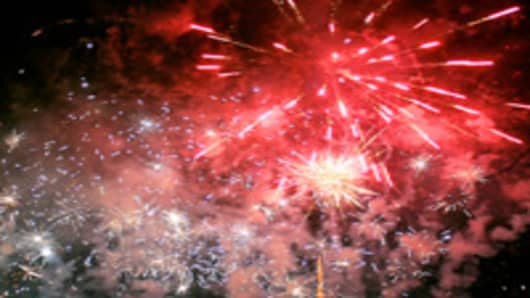Consumers may be cutting back on clothes, electronics and fancy dinners this recession, but pyrophiles across America aren't skimping on Fourth of July fireworks.
"It is going to be a banner year for the consumer fireworks industry," says Julie Heckman, head of the American Pyrotechnics Association.
"We are all depressed, we want a distraction,” she says. “People want something to elevate their mood at a relatively inexpensive cost."
Given the rising cost of gas and travel, coupled with an unemployment rate of 9 percent, Heckman expects people to stay in their backyards this year.
William Weimer, vice president of Phantom Fireworks, a retailer based in Indiana, is slightly more cautious. He expects only slightly higher sales for 2009, admitting the industry is "not immune to the economy by any stretch of the imagination."
But unlike the retail portion of the business, professional pyrotechnic firms that put on displays for towns and cities are feeling the crunch. According to Bob Kerns, director of operations at Melrose Pyrotechnics in Chicago, "Some smaller communities are having trouble raising funds." He expects sales to be slightly lower this year.
City officials in Parma, Ohio cancelled plans for a $25,000 fireworks displays amid a tax revenue shortfall of $2.4 million this year. Shows have been scrapped across the country, from San Jose, California to Niceville, Florida.
Nevertheless, Fourth of July is Christmas for fireworks retailers, who generate as much as 90 percent of sales around the holiday, according to Heckman.
She attributes steady sales to the recent liberalization of fireworks laws in states like Connecticut, Minnesota, Maryand, Indiana, Pennsylvania, Georgia and Arizona. Indeed, in Phantom's home state of Indiana, sales spiked nearly 30 percent when legislators moved from partial to complete liberalization, says Weimer.
Today just 5 states ban consumer fireworks entirely, all located in the Northeast: Delaware, Massachusettes, New Jersey, New York and Rhode Island. (Get the APA's Directory of State Laws for Fireworks Here).
Revenue for the industry as a whole is expected to reach $960 million this year, up from $940 million in 2008. Heckman says this figure has more than doubled in the past decade.
Made in China
Phantom's Weimer expects more deregulation to come as safety standards rise and reports of injuries fall.
A report released Tuesday by the Consumer Products Safety Commission revealed seven fireworks-related deaths and 7,000 injuries in 2008, the lowest figure in 18 years and a 30 percent drop from 2007.
"The imperative of government to protect people from fireworks diminishes each year," Weimer argues.
He estimates about 97 percent of fireworks consumed in the U.S. are imported from China, with 70 percent coming from a single village in Hunan province.
These imports have faced stricter quality controls, says Weimer. During the American Fireworks Standards Lab's first test of Chinese products in 1994, 36 percent of products failed to pass U.S. manufacturing standards. By 2006 that figure had dropped to just 7 percent.
Despite these statistics, Sarah Hecker, spokesperson for Prevent Blindness America, highlights the inherent dangers of fireworks to children in particular.
Forty percent of injuries in 2008 were incurred by kids under 15, a figure that has remained steady for years, according to the CPSC report.
Even the least regulated of all fireworks, so-called “novelties” like sparklers and smoke bombs, can reach temperatures of 1,800 degrees Fahrenheit and are the leading cause of injury for children under 5 years old, says the CPSC.
"Fireworks are wonderful if set off by trained professionals," says Hecker. “It is still something that is very dangerous."
Ninety-seven percent of injuries last year were caused by fireworks launched by amateurs, with about 70 percent incurred during the month around the Fourth of July.
Despite the dangers, Americans purchased over 238 million pounds of explosives in 2007, up from 100 million in 2000, says the APA. The consumer market is the fastest growing segment of the industry, comprising two-thirds of revenues.
Weimer asserts that these figures prove John Adams was right when he predicted in 1776 that the national holiday would forever be celebrated "with bonfires and illuminations."
"Translated to 21st century vernacular," he says with gratification, "that means barbecues and fireworks."


